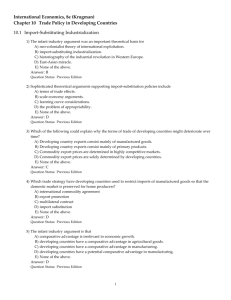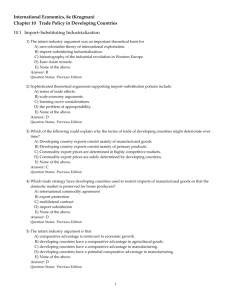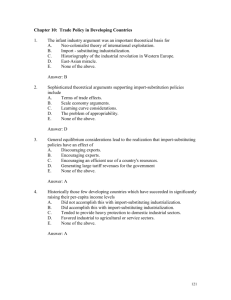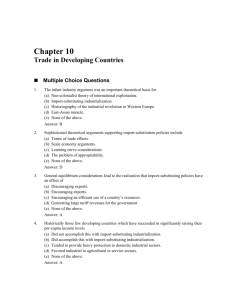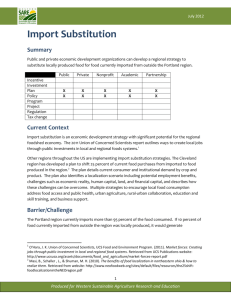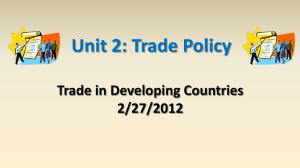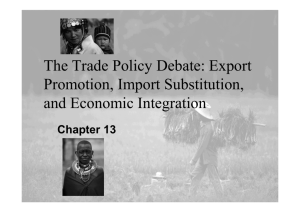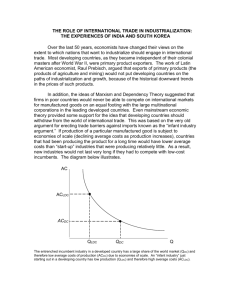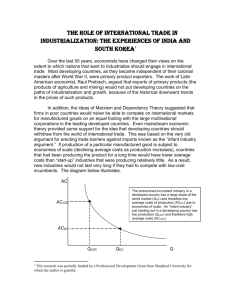Ch10
advertisement
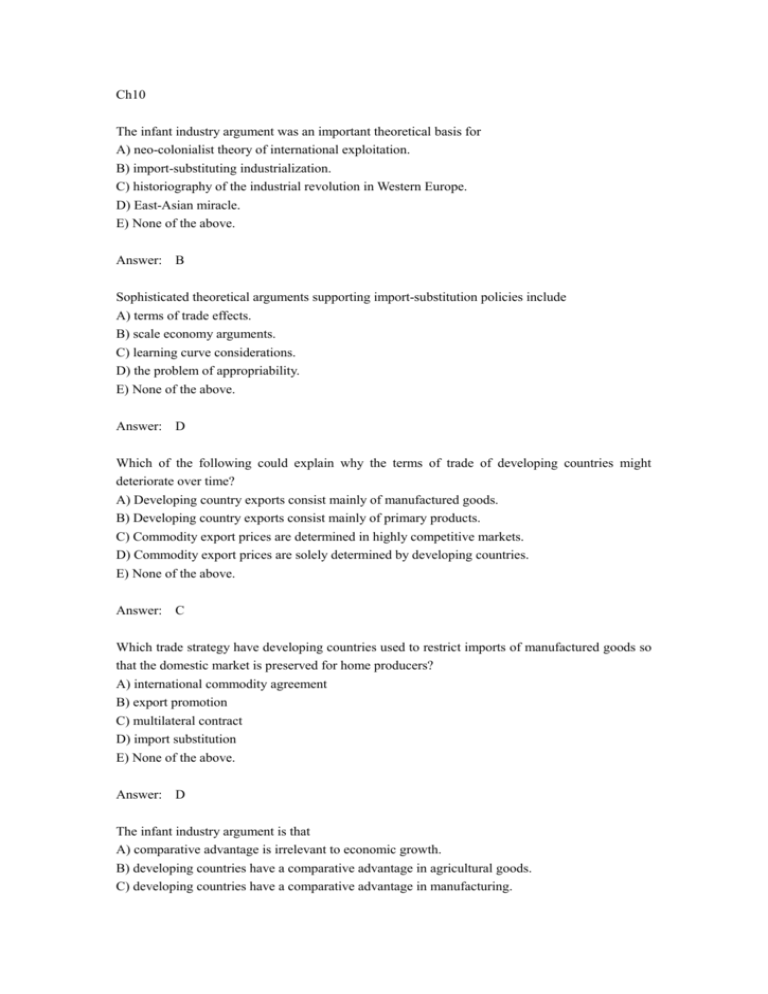
Ch10 The infant industry argument was an important theoretical basis for A) neo-colonialist theory of international exploitation. B) import-substituting industrialization. C) historiography of the industrial revolution in Western Europe. D) East-Asian miracle. E) None of the above. Answer: B Sophisticated theoretical arguments supporting import-substitution policies include A) terms of trade effects. B) scale economy arguments. C) learning curve considerations. D) the problem of appropriability. E) None of the above. Answer: D Which of the following could explain why the terms of trade of developing countries might deteriorate over time? A) Developing country exports consist mainly of manufactured goods. B) Developing country exports consist mainly of primary products. C) Commodity export prices are determined in highly competitive markets. D) Commodity export prices are solely determined by developing countries. E) None of the above. Answer: C Which trade strategy have developing countries used to restrict imports of manufactured goods so that the domestic market is preserved for home producers? A) international commodity agreement B) export promotion C) multilateral contract D) import substitution E) None of the above. Answer: D The infant industry argument is that A) comparative advantage is irrelevant to economic growth. B) developing countries have a comparative advantage in agricultural goods. C) developing countries have a comparative advantage in manufacturing. D) developing countries have a potential comparative advantage in manufacturing. E) None of the above. Answer: D The infant industry argument calls for active government involvement A) only if the government forecasts are accurate. B) only if some market failure can be identified. C) only if the industry is not one already dominated by industrial countries. D) only if the industry has a high value added. E) None of the above. Answer: B The imperfect capital market justification for infant industry promotion A) assumes that new industries will tend to have low profits. B) assumes that infant industries will soon mature. C) assumes that infant industries will be in products of comparative advantage. D) assumes that banks can allocate resources efficiently. E) None of the above. Answer: A General equilibrium considerations lead to the realization that import-substituting policies have an effect of A) discouraging exports. B) encouraging exports. C) encouraging an efficient use of a country's resources. D) generating large tariff revenues for the government. E) None of the above. Answer: A Import substitution policies make use of A) tariffs that discourage goods from entering a country. B) quotas applied to goods that are shipped abroad. C) production subsidies granted to industries with comparative advantage. D) tax breaks granted to industries with comparative advantage. E) None of the above. Answer: A Brazil's export record in 1999 illustrated the principle that A) a large country will tend to have few exports. B) a small country will tend to have a high export ratio. C) protectionist policies tend to discourage exports. D) export-promoting policies do not tend to work. E) None of the above. Answer: C The disappointment with import-substitution policies is in part because A) the rapid and continuous growth record of South American countries. B) many countries pursuing this strategy experienced stagnation in their growth. C) this policy is inconsistent with sophisticated economic growth models. D) this policy tended to create world-class industrial competitors. E) None of the above. Answer: B The relatively rapid economic growth experienced by Chile in the late 1980s A) supported the conventional Latin American reliance on import substitution. B) relied on the Harris-Todaro model to explain this growth. C) rejected the conventional Latin American reliance on import substitution. D) demonstrated the importance of market failure as a reason for import substitution. E) None of the above. Answer: C To help developing countries expand their industrial base, some industrial countries have reduced tariffs on designated manufactured imports from developing countries below the levels applied to imports from industrial countries. This policy is called A) export-led growth. B) generalized system of preferences. C) Most Favored Nation. D) reciprocal trade agreement. E) None of the above. Answer: B To help developing nations strengthen their international competitiveness, many industrial nations have granted tariff reductions to developing nations under the A) international commodity agreements program. B) multilateral contract program. C) generalized system of preferences program. D) export led growth program. E) None of the above. Answer: C Export-led growth tends to A) discourage competition in the global economy. B) exploit domestic comparative advantages. C) lead to unemployment among domestic workers. D) help firms benefit from diseconomies of large-scale production. E) None of the above. Answer: B The experience of Chile's foreign sector in the last two decades of the 20th Century supports the proposition that economic growth is supported by A) import substitution. B) industrialization policies. C) trade liberalization policies. D) Both A and B above. E) None of the above. Answer: C Historically those few developing countries which have succeeded in significantly raising their per-capita income levels A) did not accomplish this with import-substituting industrialization. B) did accomplish this with import-substituting industrialization. C) tended to provide heavy protection to domestic industrial sectors. D) favored industrial to agricultural or service sectors. E) None of the above. Answer: A Statistical evidence suggests that A) free trade policies promote economic growth more effectively than do import substitution policies. B) import substituting policies tend to promote effective exploitation of scale economies. C) import substitution tends to lead to relatively low effective rates of protection. D) import substitution is to this day the preferred growth strategy promoted by the World Bank. E) None of the above. Answer: A The growth successes of the high performance Asian economies A) supports the belief that economic development requires import substitution policies. B) rejects the belief that export-oriented industrialization is likely to promote economic development. C) rejects the belief that economic development requires import substitution policies. D) suggests that free trade policies are required for successful economic development. E) None of the above. Answer: C Which industrialization policy used by developing countries places emphasis on the comparative advantage principle as a guide to resource allocation? A) export promotion B) import substitution C) international commodity agreements D) Infant Industry promotion E) None of the above. Answer: A Taiwan and South Korea are examples of developing nations that have recently pursued these industrialization policies A) import substitution. B) export promotion. C) commercial dumping. D) multilateral contract. E) None of the above. Answer: B The development of countries like South Korea has been supported by all of the following except A) high domestic interest rates. B) high domestic saving rates. C) large endowments of human capital. D) high levels of labor productivity. E) None of the above. Answer: A The "East Asian Miracle" is A) the ability of so many people to live in such small areas. B) the fact that so many Influenza varieties originate from this region. C) the fact that poor dualistic economies managed to escape the vicious circle of poverty. D) the ability to maintain large positive trade balances with the U.S. E) None of the above. Answer: C The HPAE (High Performance Asian Economies) countries A) have all consistently supported free trade policies. B) have all consistently maintained import-substitution policies. C) have all consistently maintained non-biased efficient free capital markets. D) have all maintained openness to international trade. E) None of the above. Answer: D The HPAE "economic miracle" illustrates a clear case in which A) exports and growth were positively related. B) exports were promoted by successful economic growth. C) economic growth was determined by successful export promotion. D) trade policy dominated other considerations in promoting economic growth. E) None of the above. Answer: A The "East Asian Miracle" of the "Four Tigers" in the 1960s was replicated by A) developing countries around the world. B) other East Asian countries. C) Sub Sahara African countries. D) Industrialized countries. E) None of the above. Answer: B


